The Vision of Smart Urban India
A.K. Jain[1]
India’s 7936 cities and towns, comprising 4041 statutory and 3895 census cities/towns, have a population of 377 million. These provide 60 per cent of the GDP and 70 per cent of the jobs. It is projected that with a growth rate of 2.76 per cent per year by next 20 years India will add 200 million urban population. This poses a huge challenge of inclusive and integrated urban planning, development and governance, especially in the context of poverty, climate change, water and energy, transport and housing.
Notwithstanding the fact that many Indian cities are abysmally poor, they are still the engines of productivity. However, poor infrastructure services, mobility, housing, crimes, environmental degradation, health and educational facilities are acting as a retardant in wealth creation and productivity. The potential can be enhanced by better infrastructure services, cleanliness, mobility, governance, innovation in technology and better and equitable housing.
India’s urban housing shortage is around 18.78 million and the EWS and LIG sections have no access to formal housing finance. The 2011 Census found that nearly 65.5 million people reside in slums in Indian cities (13.9 million households). As per 2011 Census, 70.6% of urban population is covered by individual water connections. However, supply is often inadequate and poor in quality. As per MOUD (Ministry of Urban Development, 2010), none of the 483 cities studied had ‘healthy and clean drinking water. As per WHO, among 132 countries, India’s air quality is the world’s unhealthiest. The particulate matter in the air of 180 Indian cities was six times higher than the World Health Organisation standards.
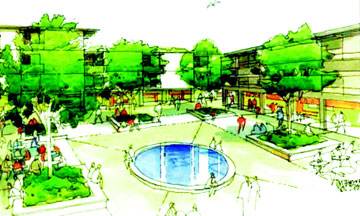 |
Recent policies and key missions envisage a vision of a smart urbanized India. In order to meet the growing aspirations of people and to respond to the daunting challenges of urbanisation, it is necessary to provide infrastructure services in all urban centres, with stress on water, sanitation, capacity building, waste management and roads. To address these issues, the Government of India has a vision of a ‘smart urbanized India’ and a commitment to develop 100 smart cities. These cities will focus on specialized domains and equipped with world class amenities, facilities, connectivity and better environment. Existing cities will also be made smart by development of networked infrastructure, services, digital planning, and e-governance. Wherever possible, twin cities and towns will be developed.
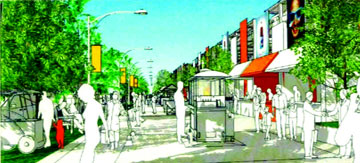 |
For improving the existing cities, the Urban Development Mission focuses on the concepts of digital planning, smart infrastructure services, mobility, Wi-Fi connectivity, public health and hygiene, toilets, and solid and liquid waste management. The Urban Development Mission targets 500 cities, which is estimated to cost Rs. 16.50 lakh crores.
The Heritage City Development and Augmentation Yojana (Hridya scheme) aims to rejuvenate heritage cities commencing with seven pilgrimage cities, viz. Amritsar, Ajmer, Gaya, Kanchipuram, Mathura, Varanasi and Vellankani. For this a budget of Rs 500 crore has been sanctioned.
The government under the Sardar Patel National Mission for Urban Housing endeavours to provide housing for all by 2022, that is by the time the nation completes 75 years of Independence. This involves building 30 million houses for the urban poor with an estimated investment of Rs 22.5 lakh crores. For rehabilitation of the slum dwellers, it is proposed to construct dwelling units measuring 30 sqm of which the Central Government will bear 75 per cent of the construction cost, while the remaining amount will be borne by the States.
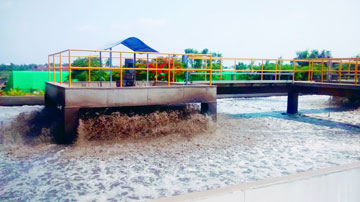 |
For a balance between rural and urban infrastructure and amenities and their integration the 'urban' model of development will be adopted. It aims to provide urban facilities and infrastructure services, roads, water, electricity, cleanliness and sanitation in the rural areas. This points out towards reviving and implementing the concept of integrated development of urban and rural areas by District Planning, which is a constitutional mandate. It may be noted that the preparation of City Development Plan (CDP) under the JNNURM is not in the line with the 73rd and 74th Constitutional Amendment Acts (CAA). The District Planning approach aims to promote participatory local planning with empowered local bodies and devolution of powers and finances.
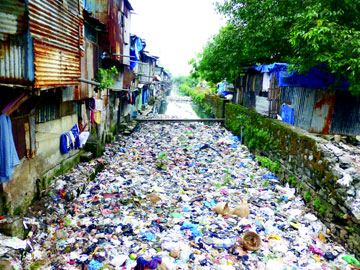 |
The Swachh Bharat Abhiyaan (Clean India Campaign) was launched on 2nd October, 2014, on Gandhi Jayanti at Rajghat, New Delhi. The primary goal of the campaign is to achieve the vision of a ‘Clean India’ by October 2019 which will mark the 150th birth anniversary of Mahatma Gandhi. Urban Development Ministry has set aside Rs. 62,000 crores for the urban areas and the Ministry of Drinking Water and Sanitation will spend Rs.1,34,000 crores for the rural component. The focus is being given to the cleanliness, sanitation, public hygiene and individual toilet facilities, which are essential for a healthy environment.
Recently, the Government of India has revived its efforts to rejuvenate and clean the rivers, starting with the Ganga. The rivers provide water to sustain the life, agriculture and industry and are also the nodes of religious and cultural congregations. 2510 km long river Ganga flows through 11 States and supports a population of 500 million, with several pilgrim cities along it.
These separate initiatives can transform the picture of urban India by joining the dots.
| Mission |
Functional Areas |
|
Smart Cities and Urban Development Mission
|
- Energy networks, smart grids, renewable energy grid, energy efficiency, electric vehicles, bionic controls, minimise need for air-conditioning
- Intelligent water network with minimum losses and leakages,
- Waste management, food supply, circular metabolism
- Multi-modal, pollution free mobility with smart cards, Smart signals, traffic controls, variable signage, mobile enabled real time maps/routes, way finding, parking, traffic regulation, safety and security, accident monitoring, multi-modal transport integration, ‘Z’ stations unifying bus, train, metro, IPT and last mile connectivity
- Education and healthcare services
- Recreation, greens, etc
|
| Clean, Open Defecation Free Cities |
- Every house to have a toilet, sanitation
- Sewerage and public toilets, waste collection and recycling, bio- methanisation, vermi-composting, incineration, etc.
|
| River Cleaning and Rejuvenation |
- Integrated and participatory approach, synergy among socio-cultural, environmental, technical, financial and legal aspects.
- Continuous flow of water, closing polluting industries, interceptor drains, CEPTs, wastewater cleaning, recycling, zero run-off drainage, green and blue networks
|
| Rejuvenation and Conservation of Heritage |
- Conservation of historic cities, natural and built heritage, pilgrim cities, heritage areas, zones and buildings
|
| Housing for All |
- Integrated housing plans, including slums rehabilitation, services, education, health and community facilities
- Land bank, GIS, SDI, reservation of land for social housing, tenure
- Finances, mobilizing public, private and community resources
- Building Information Management, single window building plan approval, technology, building systems and innovations, housing management
|
| Urban Governance |
- Land Information System, digitized mapping, SDI, Geo-portal, GIS based property records, plans and transactions, On line approvals, banking, taxation and payments
- Broadband development, automation and internet access, Public Security System, mobile based governance
|
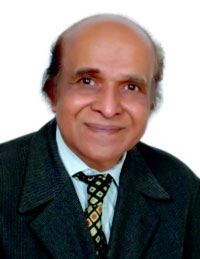 |
[1]Former Commissioner (Planning) DDA. According to Christopher Benninger "A. K. Jain spent a meaningful career in planning for Delhi. He was a leader in a wide range of complex issues of shelter strategies, retail, offices, recreation and open spaces, institutions, manufacturing, urban infrastructure, social amenities and transportation. He was an early proponent of sustainable cities and conservation. One could say without hesitation that the author is one of the “makers of modern Delhi." ak.jain6@gmail.com |
The Concept of Smart Cities
 |
The Smart City intersects between Competitiveness, Capital and Sustainability. Smart city means good governance, providing efficient health and education, 24x7 power and water, efficient transport, high quality sanitation, employment to masses and robust cyber connectivity. A city should provide reliable infrastructure, health care, attract investments by transparent business processes, simple and on line processes for various citizen services. This is possible by invoking smart, computerized services and communication. Standardization, automated production, intelligent services, transportation, information technology, wired buildings and energy efficiency are de rigueur of a smart city. The urban sector in India can’t afford to postpone embracing the state of art urban services, such as smart, intelligent and bionic processes, gender safety, simulation, automation and robotics, renewable energy, solar mapping, etc. These are vital in making cities sustainable and inclusive. These also enable a wider public participation, online consultation of citizens in decision making.
Digital Planning: A city plan based on digital and GIS technology should realize full potential of resources, land and skills, while efficiently running daily operations.
Human Resource: A city must provide services that support the social, cultural, health and educational needs of citizens.
Smart space design: Integration of various land uses, transport network and physical and social services on a common network helps optimize use assignment and space configurations, eliminating underperforming space, with a significant increase in the productivity.
Smart Infrastructure: ICT (Information and Communication Technology) enabled infrastructure, comprising wireless devices, data centres and digital analytics can made the city and its services more efficient with a low carbon footprint. This needs new ways of planning and infrastructure management. Basic infrastructure services such as water, energy and transportation need to be made intelligent, smart and sustainable.
A blueprint for smart city focuses on intelligent computing infrastructures with cutting-edge advances in cyber-physical systems and innovation support the cities and achieving effective operations and smarter buildings.
Energy efficiency, smart grid and renewal energy are integral to sustainable energy. The Government is supporting the ‘Development of Solar Cities’ that provide impetus to urban and local bodies in creating renewable energy cities. Geothermal heating and cooling system envisage circulating air through a grid of underground pipes, where the temperature is always between 15°C to 25°C. The living pattern should manifest a circular metabolism, replacing the existing linear system of input-output. The building has not only to be comfortable, green and energy efficient but also intelligent.
ICT can help in improved and speedy repair of the infrastructure and respond to emergencies. The maintenance of the utilities and equipments can be substantially improved, while minimizing “windshield time”. Recycling of waste water, rain water harvesting, coupled with waterless toilet will save the environment and avoid impending water crisis.
In smart city public transport is the principal mode of transportation. Metro and rail network, Bus Rapid Transit (BRT) systems have been implemented by the various cities. These have to be integrated with the strategies of the transit-oriented development (TOD) that entail clusters of compact, high density, mixed use development that provide housing, employment and recreational facilities, around public stations or corridors. TOD enables strengthening the ridership and use of public transport among all economic classes. This also needs providing last minute connectivity, integration of multi-modal public transit and smart card. Walking continues to be one of the primary means for travelling for the common Indian. The provision of dedicated walking and pedestrian safety allow an efficient flow of traffic and reduced accidents.
 |
Clean, Open Defecation-Free Cities: India is ashamed by widespread open defecation, which is highest in the world. According to National Sample Survey Office (NSSO) data 69.3% of rural and 18.6% urban households do not have toilets. According to the 2011 census, only 46.9% of the 246.6 million households have lavatories while 49.8% defecate in the open. The remaining 3.2% use public toilets. CRY survey report (2012) reveals that 37 percent schools in Delhi do not have functional toilets. Schools and public toilets often suffer from major flaws such as blocked sewerage, broken doors and no water. The Annual Status of Education Report for 2010 (ASER) confirms the link between providing separate toilets for girls in schools and girls’ dropout rates. The Supreme Court of India passed a directive to all the State Governments and Union Territories to provide toilet facility in all schools of the country by November 2011. The deadline has been crossed and yet 41 per cent schools do not have toilet facility for girls.
Liquid Waste and Sewerage: The existing capacity of sewerage system in Indian cities is grossly inadequate, as only about 55% of the population is covered under organised sewerage system and about 15% by on-site sanitation systems. Rest of the population does not have proper access to toilet and sanitation facilities. The increasing pollution in the rivers and water bodies is largely due to lack of sewage treatment facilities.
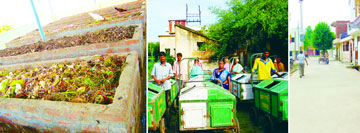 |
To improve the sewerage and sanitation, the surface drainage, water supply, waste water treatment and sanitation need to be developed in an integrated manner. This involves appropriate locations for sewage treatment plants (STPs), sewage pumping stations, recycling plants for waste water, common effluent treatment plants (CETPs) and distributive infrastructure, i.e. conveyance system to be laid to carry treated wastewater from STPs to the areas for alternative uses. Decentralised STPs with smaller capacities can be provided at the community level. Possibility of recovering energy/ gas from sewage could also be explored.
The sewerage system is designed to handle domestic liquid waste @ 80 % of the water supply. The wastewater is also generated due to the use of ground water from the boreholes, which needs to be taken into account for provision of water recycling infrastructure and treatments. The treated sewage effluent can be used for gardening, washing, cooling towers, etc.
Solid Waste: The problem of solid waste management in Indian cities is assuming serious proportions due to increasing population, changing lifestyles and consumption patterns. The garbage from unauthorised colonies, slums, Jhuggi-Jhompri (JJ) settlements, etc. is hardly collected which further adds to the environmental degradation. The projected average urban garbage generation in the year 2021 would be 2 lakh MT per day @0.5 kg per capita. Already large cities like Delhi generate about 10,000 MT of garbage everyday @ 0.68 kg per capita per day. Apart from domestic and office wastes, it also includes biomedical waste; hazardous waste from industries; construction debris, fly ash; meat processing, electroplating industry, automobile garages, etc. which require special handling. Major part of solid waste is usually disposed of in sanitary landfills. The Rules prescribe the segregation of solid waste in separate bags of green and black colour; however, this is hardly implemented.
Land available for disposal of waste is shrinking fast, which is leading to a very challenging situation. Due to changing lifestyle, the waste material is becoming more complex with increasing plastic film, tetra packs, batteries, chemicals, e-waste, etc. Inert material in the municipal waste has been steadily increasing (30-50%), a majority of which is generated from the demolition and renovation activities. E-waste is a fast emerging issue which remains to be addressed properly. It is time that buy back and similar systems are deliberated upon and put in place. Source segregation, transportation and avoidance of contamination are important issues which are very difficult to achieve in practice.
A study conducted by the World Health Organisation titled "Management of Solid Waste in Developing Countries" concluded that for cost effective, efficient waste management, a policy of encouraging multiple small composting plants should be followed. Another study called "Garbage Disposal Economics : A Statistical Snapshot" concluded that recycling waste is by far the cheapest alternative to landfills; and plants that convert garbage into other products are far cheaper than those that burn garbage. Cities might therefore choose to build several small, decentralised waste facilities rather than large one. Decentralisation also reduces transportation costs".
An alternative is setting up Solid Waste Energy and Recycling Facility (SWERF). SWERF reduces the need for future acquisition of land for landfills by 90 per cent. Odours and health risks are reduced as the SWERF is totally enclosed. There is sterilized handling of wastes and recyclables as the municipal solid waste is first processed in an autoclave. Greenhouse gases are reduced to the maximum by efficient conversion technology. Some options of Solid Waste Management that can be adapted according to waste characteristics and local context, includes the following:
- Recycling, conversion of plastic waste into diesel/LPG, conversion of debris into building /road blocks.
- Energy Recovery from Waste
- Bio -methanation Technology
- Fuel-Pellets
- Incineration Technology
- Pyrolysis /Gasification Technology
- Composting (aerobic window, an aerobic, tunnel, bio-reactor in vessel, etc.) and Vermi-composting
- Pneumatic waste collection
In Bogotá incentives like free bus ticket, food coupons and cinema tickets are given to individuals, and rag pickers for depositing waste in the designated municipal waste collection centres. Learning from Colombia and Brazil where the rag pickers are officially recognized, Pune Municipal Corporation has also brought them in Municipal SWM loop and provides them with remuneration, uniforms, gloves, pushcarts and health insurance.
River Cleaning and Regeneration: Almost every Indian city is situated along a river or water body, which is not only the source of water, but also has a social, cultural and religious value. However, with indiscriminate urbanization these have become polluted and dirty. River Ganga was ranked among the top five most polluted rivers of the world in (2007). The faecal coliform level in the river near Varanasi is more than 100 times the norms. One billion litres of raw, untreated sewage is estimated to flow daily into the river. In Uttar Pradesh out of 742 towns and cities, only 17 have sewage treatment plants (STP). As a result most of the sewage, estimated at 2900 million litres, flows into river. 10,000 dead bodies are thrown into the river each year, besides cremation of 40,000-50,000 bodies on its banks and disposal of ashes of lakhs of the dead every year. The river stretch from Kanpur to Kannauj is most polluted, mainly due to industries and tanneries. Ganga Manthan organized by the National Mission for Clean Ganga during July 2014 revealed that sewage accounts for 95 per cent of river pollution in big cities such as Varanasi, Kanpur and Allahabad. According to the scientific studies of water samples from the upper Ganga, the levels of resistance genes, which lead to spread of life threatening bacteria and superbugs are 60 times higher than the permissible norms as lakhs of visitors and pilgrims travel Varanasi, Allahabad, Rishikesh and Haridwar during the summer. Encroachments and construction in river bed, illegal mining of sand and water are other major issues, which have become rampant.
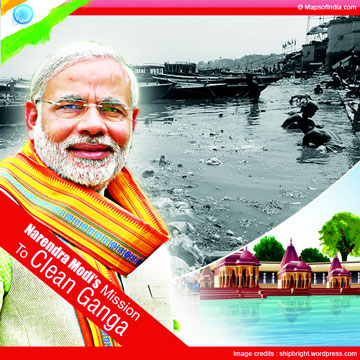 |
About Rs. 20,000 crores have been spent under the Ganga Action Plan (GAP) since 1986 and about 3,000 crores under Yamuna Action Plan (YAP) since 1993. Both have been abject failures. The conventional sewerage models and techno-environmental approaches have not worked. The issues are closely intertwined with the social, cultural and religious context, whereby the community participation and governance have a key role in the rejuvenation and cleaning of the rivers. This implies coordinated actions, which synergise socio-cultural, environmental, political, administrative, technical and financial aspects. The institutions connected with the river have to be professional and capable of working with the public and understanding the nuts and bolts of social engineering. Without public support and participation, it is not possible to achieve the purity of the rivers.
 |
About 90 per cent of river water is diverted into drains and canals and most of the remaining water is stored for urban use, leaving the rivers high and dry. Especially during the summer, the rivers do not have continuous flow, lack oxidation and become stagnant. This is major cause of their pollution. To ensure the flow of water in the river throughout the year release of water from upstream barrages and development of reservoirs in low lying areas are necessary. Up-gradation of water quality to prescribed standards needs to be ensured and monitored. By de-silting the existing pondage areas can be enhanced. Construction of micro-dams upstream will help collecting the monsoon excess which can be released in the rivers during lean periods. However dams and canals should not pre-empt the river navigation and fish culture, which can be the practical triggers for organic pristine purity of a river. The soft landscape and vegetation along the river banks will allow rainwater to be absorbed, rather than running off. Natural in-stream elements, e.g. root wads of downed trees provide essential slow-water habitat for fish and insects that will regenerate native wetlands.
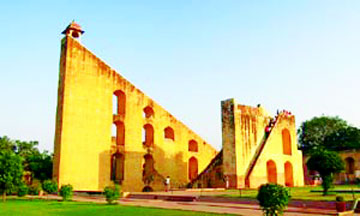 |
While curative action, such as installation of treatment facilities is necessary, more important is preventive action. This involves removal of non-compatible and pollution generating land uses, industries, garbage dumping and often defecation, from the river zone and also cleaning of major drains and controlling the dumping of solid waste and untreated sewage into rivers and drains. Innovative, economical and pragmatic solutions like primary treatment, bio-remediation, oxidation ponds, aeration, etc. can be employed to treat waste water. For treatment of pesticide traces, capping the existing sand bed with bituminous charcoal or coconut shells can be an easy and inexpensive solution. Increasing flocculants by adding powered activated carbon (PAC) or bentonite clay with doses varying from 25-30 mg/l and the use of granular activated carbon can be effective, subject to its cost. Raw water tanks and rainwater storage can be protected by clay beds, which should be secured from getting washed away during the monsoons. The best way to get rid of the pesticides (non-point) and industrial toxins is through “source protection measures”, i.e. protect the catchments through methods such as organic or biological farming.
Interceptor sewers along the major drains can help in checking the sewage flowing into the river. This also needs putting up Sewage Treatment Plants (STPs) and to augment the capacity of existing STPs and recycling the effluents and wastewater. The unsewered areas, viz., slums, unauthorized colonies, resettlement colonies, villages, etc. can be provided with alternative, decentralized sewage systems. As river cleaning is connected with the water, drainage, solid waste management and transport networks, all these need to plan together with appropriate technology and participation of the people, infrastructure agencies and other stakeholders. An important aspect is to develop consistent and sturdy arrangements for the operation and maintenance of the systems. For promoting recycling, incentives, such as rebate on property tax, subsidy on water charges, can be given if recycled water is used. For enhancing the reuse of treated wastewater, a phased programme should be developed.
To ensure the conservation of the eco-sensitive nature of the river zone and to take up the removal of polluting and non-conforming activities from it, a legal shield is a must. The agencies dealing with the river, land, water, power, irrigation, drainage and sewerage should work together to evolve coordinated water supply-sewerage-drainage and flood control schemes, and preparation of integrated environment management plans. The regularization of encroachments, religious structures, industries, commercial activities and unauthorized colonies in river zone/flood plain should be avoided and carefully dealt with, keeping in view its eco-sensitive nature and within an overall policy framework.
No development, including construction of road and railways, should be taken up without a comprehensive Watershed & Environment Management Plan. It is necessary to integrate the river within the larger framework of the topography, hills, villages and cities that will bring the river closer to the citizens by placing public activities with last mile connectivity. Emphasis should be given to selection of plant material/greenery and design of landscape, signage system and outdoor furniture. Outdoor publicity, hoardings, etc. should be strictly prohibited in the riverfront and river zone.
Rejuvenation and Conservation of Heritage: India’s cultural, historical and archaeological heritage assets rank as one of the finest in their diversity and antiquity, they are as varied as they are rich. However, the pressure of rapid urbanization, commercialization, inadequate financing and poor enforcement have put this rich cultural treasure under serious threat of deterioration and decay. The images of smart cities being projected by the consultants are scary, which can be in China, Dubai, Europe or Australia. They do not relate to Indian culture. It is necessary to work out a design vocabulary for smart cities, which retains and respects the Indian culture. The challenge is to design and preserve the whole city and its physical, cultural, social and economic revitalization. This should start with the historic and pilgrim cities and make them smart, clean and sustainable.
Effective management of heritage requires its integration with overall planning and development process, which encompasses delineation and listing of historic settlements, pilgrimages, zones/precincts and heritage buildings. These can be improved with infrastructure development, safety systems, signage, landscaping, mobility, tourist facilities, information centre, public toilets and rest rooms, dharamshalas, bread and breakfast facilities, camping sites, heritage museums, cultural centres, haats, art galleries, training centres for local arts and crafts, heritage institutes, etc.
The conservation of heritage should involve public, along with awareness generation programs, institutional capacity building, information system and listing of heritage zones/ precincts.
Housing for All
 |
The social housing shortage, growth of slums and informal settlements, even after 67 years of the Independence is one of the most dismal testimony of the failure of the authorities. The poor, and even salaried class have been pushed outside the formal housing market, who are forced to seek shelter in illegal/unauthorised colonies, urban villages or in distant suburbs. This has resulted into distorted and exorbitant land and housing prices, land monopolies and huge corruption in land transactions. The housing output of the government sector has been diminishing progressively and is moving towards market led production. This is resulting in luxury housing and profit-oriented real estate market, which lack community ownership. The government is committed to provide housing for all by the year 2022. This involves building 30 million houses, and development of about one lakh hectare of residential land. Another one lakh hectare of land is required for MIG and HIG in ratio of 3:2:1 at average densities of 600 dwelling units per hectare, 300 dwelling units per hectare and 150 dwelling units per hectare respectively. At 300 Floor Area Ratio (FAR) the average dwelling unit size of 50 sqm, 100 sqm and 200 sqm would be available for three income categories. Assuming 50 per cent of city area required for social infrastructure, transport, utilities, parks, playgrounds and work centres, there is a need to assemble, plan and develop about 4 lakh ha or (4000 sq. km) of area during next five years. Looking at the land shortage and its exorbitant prices, it may not be possible to acquire required land for social housing.
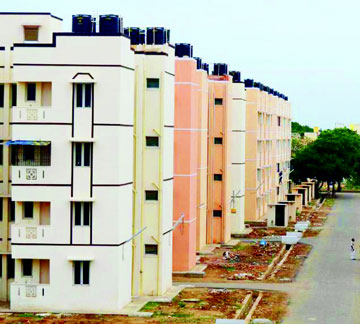 |
As a principle, for social housing (EWS/LIG) land cost should be exempted from dwelling unit cost, MIG dwelling units to include the market price of land, and HIG (dwelling size above 120 sq. m.) should include 15 per cent over and above market price of land, that would cross subsidise the social housing land component.
To overcome the ever increasing cost of the urban land and its acquisition, it is necessary that existing urban lands are recycled and developed to its optimum efficiency. Also, the slum rehabilitation and social housing projects may be deemed as a ‘public purpose’ for acquisition of land. This necessitates that the social housing projects are based upon the principle of using land as a resource, with a market sale component of housing to subsidise social housing (maximum one-third of total FAR and land), part commercial use, designed with optimum FAR and density.
The delivery of social housing can be accelerated through the implementation of reforms in the land policy, legislative, regulatory and fiscal frameworks. Linked with this is the need to review housing and planning standards which are sustainable, affordable and efficient, and the use of best available construction technologies. It is equally necessary to take up the improvement of the existing housing stock and rundown public housing areas.
Social housing should also be available on rental basis as many poor families cannot afford the down payments and EMIs. It is necessary that as a rule in any government facilitated housing scheme, at least one-fourth of housing is built/developed by individuals/plot owners, one-fourth by cooperatives/ community groups, one-fourth by government/PSU/local body and one-fourth by the private sector/PPPP. The PPP should include the people as its fourth ‘P’. It is essential to take up the capacity development of Housing Boards, Institution and cooperative housing sector. Besides private sector the communities and cooperatives should be mobilised that would help in multiplying social housing output.
For housing delivery with speed, quality and economy, it is necessary to adopt state of art, industrialised building systems. The modernisation of Hindustan Housing Factory, New Delhi can be taken as a pilot. The main objective of systems building is to achieve quality, productivity and flexibility, together with reducing time and costs. Automation and robotics give precision to pre-fabricated building components and enable accuracy and customization. Computer- Aided Manufacturing (CAM) and Computer-Integrated Manufacturing (CIM) for pre-fabricated components, viz. ceilings, walls, roofs, etc., are integral to the process of industrialized construction. The simulation of construction process enables better control of time, machine, expenditure and the manpower, which could be reduced at least by half to one-third in comparison to the conventional construction. This is also essential for the reasons of ecological sustainability and inclusive growth.
According to the Indian Exclusion Report (2013-14) of the Action Enterprise, Bangalore, 95 per cent of financing in housing sector has gone to middle and high income group from public sector banks and housing finance companies, where the shortage is a mere 4 per cent. Compared to this, only 5 per cent of the financing flowed to weaker sections and low income group housing, where the unmet need is of the order of 96 per cent. This demands a paradigm shift whereby the public sector banks and housing finance companies have to reverse their policy of housing finance. It should be mandatory to give 90 per cent of total housing loans for social housing. This is important if we want to provide housing to all by 2022.
The estimated investment of Rs 22.5 lakh crore for construction of 30 million houses does not include cost of land and infrastructure development. Besides the contribution of up to 75 per cent by the Central government, the State government and financial institutions have to be mobilised to finance and make land reservations for social housing. Under the Home Owners Mortgage Equity Subvention Scheme (HOMES) loan limit has been raised from Rs 5 lakh to Rs 10 lakh for EWS and Rs 8 lakh to Rs 15 lakh for LIG categories, along with 5.5 per cent interest subsidy on these loans. To make loans available to the poor a Rs. 1000 crore Credit Risk Guarantee Fund (CRGF) has been established, which will fund around 1.2 million affordable housing units.
15th August 2022 is only 7 years away. Planning, design, construction and delivery of 30 million dwelling units would not be possible in ‘business as usual’ way. This involves innovations in land assembly and development, planning, housing design and construction. This is a unique opportunity to introduce state of art processes, such as digital planning, spatial data infrastructure for land management and land pooling, infill development, Building Information Modelling and single window plan approvals. Intelligent and smart services, especially sanitation, water and energy and recycling of solid and liquid wastes, are necessary for sustainable environment.
Smart Governance
In any city there are more than 100 citizen services that require engagement with civic authorities. This involve for enquiries, registration, form submissions, payments, maintenance grievances, etc. The availability of Spatial Data Infrastructure (SDI), Computerised Land Records (CLR), Digital planning and e-gateway for citizen service delivery have attracted much attention in municipal governance and bringing out a silent revolution in urban governance, breaking away barriers of distance, class and gender. The digital systems are increasingly creating an emerging sociology of urban space. It is redefining and imbibing the idea of exclusion and inclusion. The smart card is already being adopted for seamless travel in public transport, access to public spaces, payment system/gateway and social services. It also makes redundant to travel to local offices, banks or government departments for public services. Digitized revolution is also helping in adopting innovative and eco-friendly urban practices, such as virtual town hall, security, traffic simulation, property registration, taxation, etc. Smart chips and systems can be embedded almost in every urban service and structure, making them smart and intelligent. These enable self-diagnosis and self- repair. The future is already upon us, and with digital chips getting embedded in a city’s epidermal and exoskeleton level and also its connective tissues, cities are increasingly getting digitally scripted and coded.
In view of the growing crimes against women and children, establishing gender sensitive and child-friendly cities has become priorities. Ensuring that women are able to travel safely is crucial for their participation in the overall social and economic development. Through endeavour of proper lighting, surveillance/CCTV identifying and avoiding vulnerable danger points, early warning, insurance provision, disaster resilient infrastructure and appropriate policing can help in safer cities for children, women and all citizens.
E-participation techniques, online consultation and mobile based public services are promoting public participation and involve the communities in planning, information sharing and arriving at solutions to their problems.
Conclusions
India is entering a new era of social and financial inclusion, economic growth and sustainable development. Its success is largely contingent upon the integrated and inclusive development of cities, infrastructure and housing for all. To take up the new agenda and the challenges of urban growth, there is a need for reviewing the urban planning practices and take a quantum leap in making the Indian cities inclusive, smart and sustainable cities.
References
- Adrian and Gordon Gill, 2011, Toward Zero Carbon, Image Pub., Australia
- Government of India (2008) PM’s council on climate change, National Action Plan for climate Change, New Delhi
- Government of India (2009), National Mission on Sustainable Habitat, MOUD, New Delhi
- IPCC (2007), Climate Change, Impacts Adaptation and Vulnerability, IPCC, Cambridge
- Publishing House, New Delhi
- Jain A.K., 2008, Urban Housing and Slums, Readworthy Publishers, New Delhi
- Government of India, (2013), Twelfth Five Year Plan, Planning Commission, New Delhi
- Jain A.K (2013), Sustainable Urban Transport and System, Khanna Publisher, New Delhi
- Jain, A.K., (2014), The Idea of Green Building, Khanna Publishers, New Delhi
- Jain, A.K., (2015), Smart Cities-Vision and Action, Discovery Publishing House, New Delhi
- Jain A.K, 2009, River Pollution: Regeneration and Cleaning, APH Publishing, New Delhi.
- Jain A.K, (2009), Low Carbon City – Policies, Planning and Practice, Discovery
- 13. McHarg, Ian, (1969), Design with Nature, Natural History Press, New York
- McKinsey Global Institute, (2010), India’s Urban Awakening: Building Inclusive Cities, Sustaining Economic Growth, Mumbai
- MOUD/ Wilbur Smith Associates, (2008), Traffic and Transport Policies and Strategies in Urban Areas in India, Ministry of Urban Development, New Delhi,
- UN Habitat, (2009), Planning Sustainable Cities, Global Report on Human Settlements, Earthscan,
- UN-Habitat (2011), Cities and Climate Change, Global Report on Human Settlements, Earthscan, UK/USA/Nairobi
- UN-Habitat (2013), Planning and Design for Sustainable Urban Mobility, Global Report on Human Settlements, Earthscan, UK/USA/Nairobi.